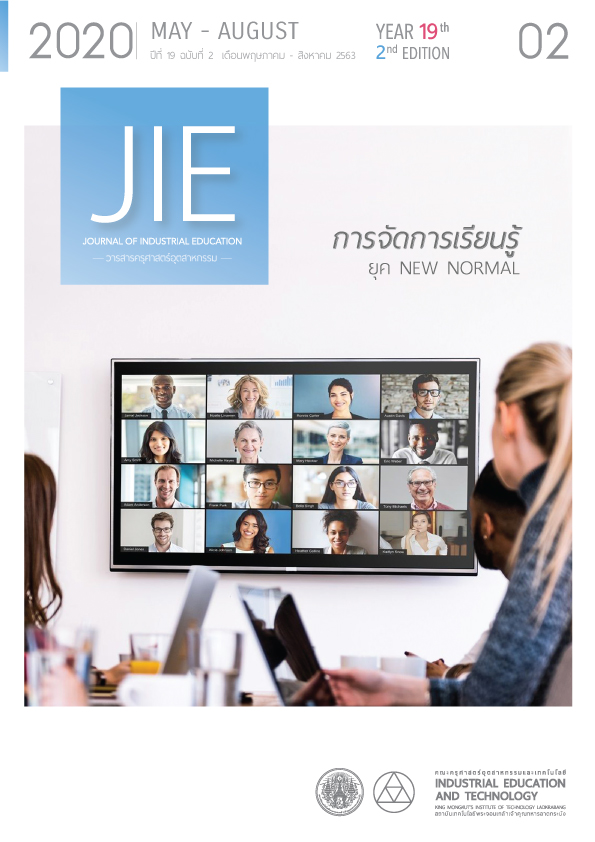A DEVELOPMENT OF INTERACTIVE MEDIA WITH AUGMENTED REALITY ON HOUSEHOLD HANDCRAFT FOR GRADE 11 STUDENTS
Keywords:
Augmented reality, Lessons developed with augmented reality technology media, Household handcraft, Lesson efficiency, interactive mediaAbstract
The purposes of this research were to develop interactive media with augmented reality on household handcraft for grade 11 students that met high quality and good efficiency and to compare the learning achievement of grade 11 students between those receiving interactive learning management using augmented reality technology as a treatment and those with normal learning in a traditional classroom. The sample group used in the study, obtained by means of Purposive Sampling, was a total number of 94 students in grade 11 at Kunnatheeruttharamwitthayakhom School who were at the time studying in the second semester of Academic year 2019. They were assigned into three groups: a group of 24 students for testing the efficiency of the research instrument, Augmented Reality Technology Media, another group as the experimental group, comprising 33 students in number, and, lastly, a group of 35 students as the controlled group. The research instruments consisted of Augmented reality technology media, the evaluation form for interactive learning media using augmented reality technology, and Achievement test with the Item Objective Congruence Index (IOC) between 0.67- 1.00, Difficulty Index between 0.38-0.75, Discrimination between 0.25- 0.58, and Reliability value at 0.81. The statistics used for data analysis were mean and standard deviation. Two Independent performed to test a hypothesis.
The results of the research showed that the overall score of Interactive learning media with augmented reality technology on the home mechanic was at a very good level ( = 4.58 , S = 0.22) . The content quality of the media was at a very good level (
= 4.88 , S = 0.17). In the aspect of media production, the media were good in quality (
= 4.28 , S = 0.65) with the efficiency E1/E2 equal to 77.92 / 75, which was in accordance with the criteria 75/75. Also, the students learning through interaction with augmented reality technology had higher learning achievement than the group with the significant difference at the level of .05.
References
Ministry of Education. 2008. The Basic Education Core Curriculum B.E. 2551 (A.D. 2008). Bangkok: Agricultural Cooperatives of Thailand printer.
Kitrungreng, N. 2002. Learner is important and writing learning plans of professional teachers according to basic education curriculum. (p.10). Bangkok: Sathaporn Books.
Wiwat Meesuwan. 2016. Development of tangrams with augmented reality. Journal of Education Naresuan University, 18(4), p. 56-68.
Chaiyong Promwong. 2013. Developmental Testing of Media and Instructional Package. Silpakorn Education Research Journal, 5(1), p. 1-20.
Monchai Thianthong. 2005. Multimedia and Hyper Media. Bangkok: King Mongkut's Institute of Technology North Bangkok.
Soontree Montreesree and Thanongsak Sovajassatakul. 2009. A development of augmented reality media on animation creation for grade 11 students. Journal of Industrial Education, 18(2), p. 40-47.
Valarmathie Gopalan, et al. 2014. A Review of the Features of Augmented Reality Science Text book. Proceedings of 1st International Conference on Creative Media, Design & Technology (REKA2014). Penang: (Brochure).
Angknana Khantreejitranon. 2019. The Effectiveness of Using Electronics Augmented Reality (AR) Based Social StoryBook to Decrease Inappropriate Behaviors of Children with Autism. Journal of Education Studies, 47(3), p. 548-567.
Piyamas Kaewcharoen and Warisara Thiraphanpiyasuphara. 2016. Development of virtual technology in brochures Computer Technology Subject. Academic journal Bangkok Thonburi University, 5 (1), p. 68-81.
Muneeroh Phadung and Soawanee Dueramae. 2019. A Development of Interactive e-Book for Thai Language Learning of Students Using Malay Dialect as a Mother Tongue in Three Southern Border Provinces. Journal of Yala Rajabhat University, 14(3), p. 318-327.
Sasiyamon Charoenphon and Apichart Sungthong. 2020. The results of using digital media in learning management by using project-based learningin physicsfor grade-11students. Journal of Science and Science Education, 3(1), p. 19-29.
Kulawan Sudjaicheun and Sa-Ngiam Torut. 2017. Effects of an English Supplementary Reading Material Focusing on Vocabulary Learning and Text Structure Analysis on Vocabulary Learning and Reading Comprehension of Mattayomsuksa Four Students of Banglane Wittaya School, Amphur Banglane, Nakhon Pathom. Veridian E-Journal,Silpakorn University, 10(1), p. 189-200.
Ratha Kansoongnern and Nammon Ruangrit. 2016. The Development Of E-Learning On English For Tourism By The Murdoch Integrated Approach (Mia) For Matthayomsuksa 4Watthamjariyapiro School Samutsakhon Province. Veridian E-Journal,Silpakorn University, 9(1), p. 702-716.
Kurotuainee Hajiabdulloh, Nuttaphong Kanchanachaya and Narongsak Roebkorb. 2019. Development of Instructional Augmented Reality Media in English Language Teaching for Grade 11 Students. Academic Journal of Buriram Rajabhat University, 11(2), p. 79-96.
Sirinthip Chansuwan. 2017. The Effects Of Learning By Augmented Reality Collaborates With Synectics Seaching Of Career And Technology Subject On Creativity In 3d Design Of Matthayomsuksa 4 Students. Veridian E-Journal, Silpakorn University, 10(3), p. 1294-1310.
Richey, R.C. 1986. The Theoretical and Conceptual Bases of Instructional Design. New York: Nichols.
Seels, B., and Glasgow, Z. 1990. Exercises in Instructional Technology. Columbus OH: Merrill Publishing Co.
Anderson & Krathwol. 2015. A Taxonomy for Learning, Teaching, and Assesing : A Revision of Bloom’s Taxonomy of Eduational Objectives (Kerangka Landasan untuk Pembelajaran Pengajaran, dan Asesmen).Yogyakarta: Pustaka Pelajar.
Downloads
Published
How to Cite
Issue
Section
License
"The opinions and contents including the words in papers are responsibility by the authors."
"ข้อคิดเห็น เนื้อหา รวมทั้งการใช้ภาษาในบทความถือเป็นความรับผิดชอบของผู้เขียน"



